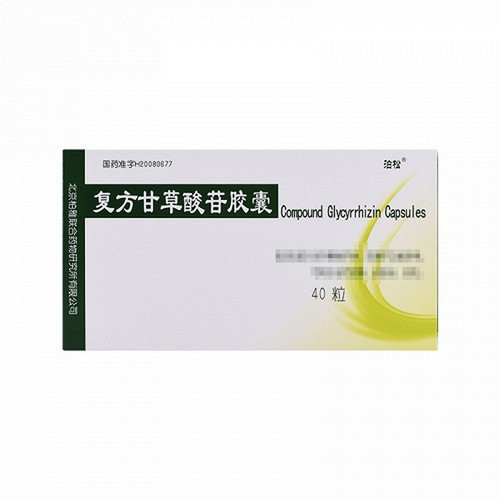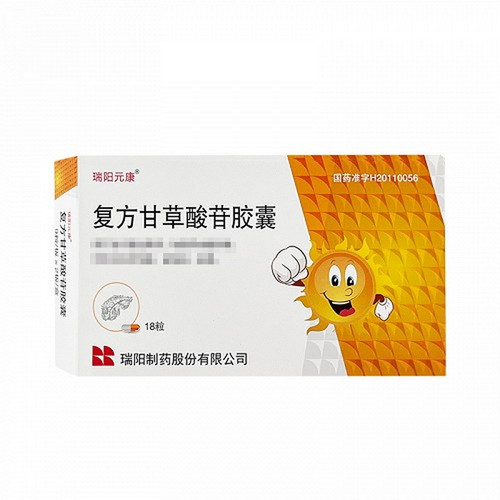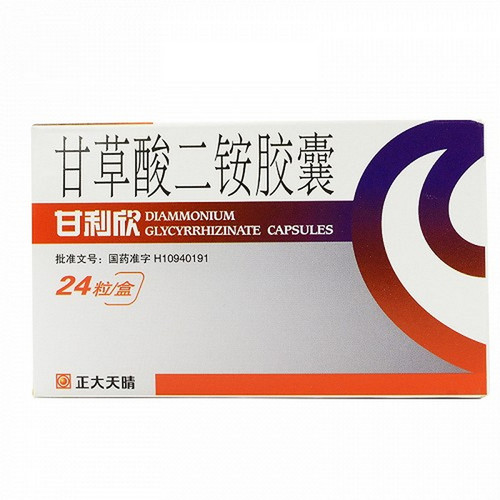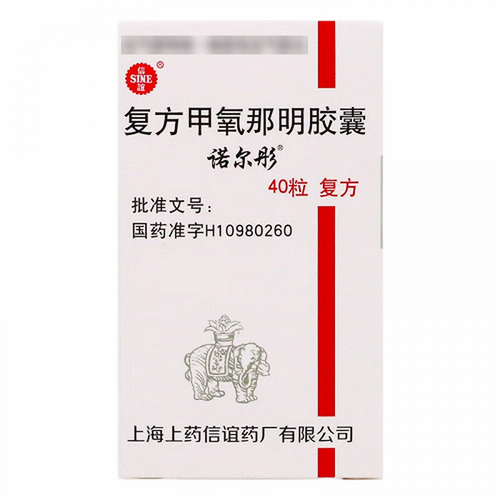Product Overview
[Drug Name]
Generic Name: Compound Glycyrrhizin Capsules
Trade Name: Ruiyang/Kang Erban
English Name: Compound Glycyrrhizin Capsules
Chinese Pinyin: FuFangGanCaoSuanGanJiaoNang (KangErBan)
[Ingredients]
Each capsule contains 25mg of glycyrrhizin, 25mg of glycine, and 25mg of methionine. Excipients also include appropriate amounts of lactose, calcium carbonate, microcrystalline cellulose, sodium starch glycolate, talc, magnesium stearate, and povidone K30.
[Properties]
This product is a capsule containing light yellow granules.
[Indications]
Treats chronic liver disease and improves liver function abnormalities. It can also be used to treat eczema, dermatitis, and alopecia areata.
[Dosage and Administration]
Adults should usually take 2-3 capsules at a time; children should take 1 capsule at a time, three times daily, after meals. The dosage may be increased or decreased based on age and symptoms.
[Adverse Reactions]
Large-scale or long-term administration of glycyrrhizic acid can cause hypokalemia, increased blood pressure, blood sodium and fluid retention, edema, and weight gain, among other symptoms of pseudoaldosteronism. Kumagai Akira believes that glycyrrhizic acid and its metabolite glycyrrhetinic acid inhibit the activity of the liver's Δ4-3Ketocteroid metabolic enzyme Δ4-reductase; Stewort believes that glycyrrhetinic acid inhibits the activity of the kidney's metabolic enzyme 11β-HCD (11-β-hydroxysteroid dehydrogenase), which converts cortisol into cortisone, causing excess hydrocortisone to replace aldosterone and bind to the kidney's type I receptor, thereby exerting a hydrocortisone-like effect. Long-term administration of glycyrrhizic acid to healthy individuals can also result in varying degrees of hydrocortisone-like effects. In addition, there are also reports that glycyrrhizic acid inhibits the activity of 11β-HCD, leading to abnormal steroid metabolism [9]. However, the occurrence of pseudoaldosteronism is limited to patients who have been given large amounts of licorice or glycyrrhizic acid for a long time, and it is also related to individual differences in these patients [10]. In fact, in a double-blind observation of chronic hepatitis patients treated with SNMC, 80 mg of glycyrrhizic acid was intravenously injected daily for 4 weeks, and no pseudoaldosteronism was observed. This is related to the route of administration and the size of the dose, as well as the compound preparation. The potential pseudoaldosterone effect of glycyrrhizic acid can be weakened by the glycine and L-cysteine contained in the compound preparation. Adverse reactions are also rare with a high-dose therapy of 100 ml of SNMC per day. Hino reported that 1 case of hypertension (1.5%) and 5 cases of hypokalemia (7.5%) were found in 65 patients, but all were mild, with blood potassium values above 3.0 mEg/L. No serious adverse reactions requiring drug discontinuation were observed. Therefore, when using compound glycyrrhizin injection and compound glycyrrhizin tablets, it is necessary to regularly check electrolytes (especially serum potassium values) and measure blood pressure. If serum potassium decreases, discontinuation of the drug may be considered. In cases of significant hypokalemia, potassium supplements are often administered, but urinary potassium excretion may also be increased. When correction of hypokalemia is ineffective, anti-aldosterone preparations (potassium-sparing diuretics) can be administered to raise serum potassium and correct elevated blood pressure.
[Contraindications]
(This drug should not be used in the following patients): 1. Patients with aldosteronism, myopathy, and hypokalemia (it may worsen hypokalemia and hypertension). 2. Patients with advanced liver cirrhosis prone to elevated blood ammonia levels (the methionine metabolites contained in this drug can inhibit urea synthesis, thereby reducing ammonia processing capacity).
[Precautions]
1. Use with caution. Elderly patients should be treated with caution (the incidence of hypokalemia is higher in elderly patients) (see Geriatric Use). 2. General Precautions: Because this drug contains glycyrrhizin, concomitant use with other licorice-containing preparations can increase glycyrrhizin levels in the body, potentially leading to pseudoaldosteronism. Caution is advised. Please read the instructions carefully and use as directed by your doctor.
[Use in Special Populations]
Precautions for Children:
For children, take one tablet three times daily, orally after meals.
Precautions for Pregnancy and Lactation:
Pregnant and lactating women should use this medication with caution after weighing the benefits against the risks.
Precautions for Elderly:
Based on clinical experience, the elderly are more susceptible to adverse reactions such as hypokalemia. Therefore, this medication should be administered with caution under close observation.
[Drug Interactions]
1. Precautions for Concomitant Use: Concomitant use with loop diuretics, ethacrynic acid, furosemide, thiazides and antihypertensive diuretics, trichloromethiazide, and chlorthalidone may cause hypokalemia (fatigue and decreased muscle strength). Serum potassium levels should be carefully monitored. 2. Mechanism and Consequences: Diuretics may enhance the potassium-excreting effect of the glycyrrhizic acid contained in this preparation, further lowering serum potassium.
[Pharmacological Actions]
Pharmacological Actions: 1. Anti-inflammatory Effect (1) Anti-allergic Effect: Glycyrrhizic acid glycoside has anti-allergic effects such as inhibiting local allergic reactions (Arthus Phenomenon) and inhibiting Schwartzman Phenomenon in rabbits. It enhances the stress response inhibitory effect of corticosteroids and antagonizes the anti-granulation and thymic atrophy effects of corticosteroids. It has no effect on the exudation of hormones. (2) Inhibitory Effect on Arachidonic Acid Metabolism Enzymes Glycyrrhizic acid glycoside can directly bind to phospholipase A2, the initiator of the arachidonic acid metabolism pathway, and to lipoxygenase, which acts on arachidonic acid to produce inflammatory mediators, selectively inhibiting the phosphorylation of these enzymes and inhibiting their activation. 2. Immunomodulatory effect: Glycyrrhizic acid glycoside has the following immunomodulatory effects in vitro: (1) regulatory effect on T cell activation; (2) induction effect on gamma interferon; (3) activation effect on NK cells; (4) promotion of extrathymic T lymphocyte differentiation. 3. Inhibitory effect on experimental hepatocyte damage In the in vitro primary cultured rat hepatocyte cell line, glycyrrhizic acid glycoside has the effect of inhibiting hepatocyte damage caused by carbon tetrachloride. 4. Inhibitory effect on virus proliferation and inactivation of viruses In the mouse MHV (mouse hepatitis virus) infection experiment, glycyrrhizic acid glycoside can prolong the survival of mice; in the rabbit vaccinia virus (Vaccinia virus) pox prevention experiment, it has the effect of preventing pox; in the in vitro experimental system, the inhibition of the proliferation of herpes virus and the inactivation of viruses were also observed. It has been reported that glycine and methionine can inhibit the reduction of urine volume and sodium excretion caused by oral administration of glycyrrhizic acid glycoside to rats. Storage: Sealed and stored in a cool, dry place.
[Specifications]
40 tablets
[Packaging]
Box
[Expiration Date]
36 months
[Approval Number]
National Medicine Standard H20110056
[Manufacturer]
Ruiyang Pharmaceutical Co., Ltd.









